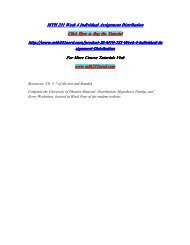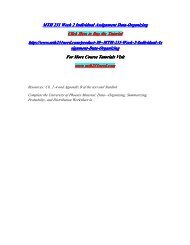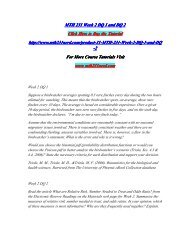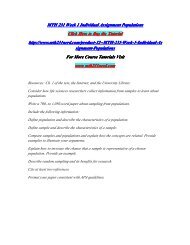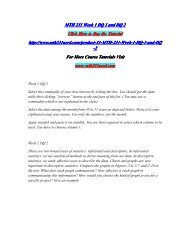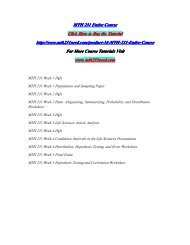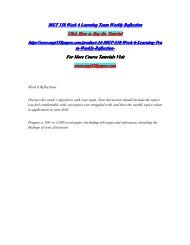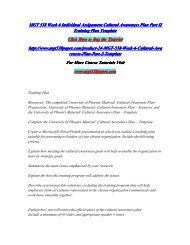MTH 231 Week 4 DQ 1 and DQ 2/MTH231nerddotcom
For More Course Tutorials Visit www.mth231nerd.com Week 4 DQ 1 State the criteria for choosing a t-test and a z-test. Then give an example of a problem in which you would use z-test to evaluate the data. Next, take the same example and modify it so that a t-test would be preferable. Explain why. Week 4 DQ 2 In general terms: • What is a null hypothesis? • What is an alternative hypothesis? Under American criminal jurisprudence, the accused is presumed innocent until proven guilty beyond the “shadow of a doubt.” • What is the null hypothesis? • What is the alternative hypothesis? • Explain how the Type I and Type II errors apply to the court system. • In court, what is the equivalent of the test statistic upon which the decision is based? • In statistical terms, how would you define “shadow of a doubt?” • In statistics, why should the decision always be stated in terms of the null hypothesis? (That is: reject the null hypothesis or fail to reject the null hypothesis.)
For More Course Tutorials Visit
www.mth231nerd.com
Week 4 DQ 1
State the criteria for choosing a t-test and a z-test. Then give an example of a problem in which you would use z-test to evaluate the data. Next, take the same example and modify it so that a t-test would be preferable. Explain why.
Week 4 DQ 2
In general terms:
• What is a null hypothesis?
• What is an alternative hypothesis?
Under American criminal jurisprudence, the accused is presumed innocent until proven guilty beyond the “shadow of a doubt.”
• What is the null hypothesis?
• What is the alternative hypothesis?
• Explain how the Type I and Type II errors apply to the court system.
• In court, what is the equivalent of the test statistic upon which the decision is based?
• In statistical terms, how would you define “shadow of a doubt?”
• In statistics, why should the decision always be stated in terms of the null hypothesis? (That is: reject the null hypothesis or fail to reject the null hypothesis.)
- No tags were found...
You also want an ePaper? Increase the reach of your titles
YUMPU automatically turns print PDFs into web optimized ePapers that Google loves.
<strong>MTH</strong> <strong>231</strong> <strong>Week</strong> 4 <strong>DQ</strong> 1 <strong>and</strong> <strong>DQ</strong> 2<br />
Click Here to Buy the Tutorial<br />
http://www.mth<strong>231</strong>nerd.com/product-27-<strong>MTH</strong>-<strong>231</strong>-<strong>Week</strong>-4-<strong>DQ</strong>-1-<strong>and</strong>-<strong>DQ</strong><br />
-2<br />
For More Course Tutorials Visit<br />
www.mth<strong>231</strong>nerd.com<br />
<strong>Week</strong> 4 <strong>DQ</strong> 1<br />
State the criteria for choosing a t-test <strong>and</strong> a z-test. Then give an example of a problem in<br />
which you would use z-test to evaluate the data. Next, take the same example <strong>and</strong> modify<br />
it so that a t-test would be preferable. Explain why.<br />
<strong>Week</strong> 4 <strong>DQ</strong> 2<br />
In general terms:<br />
• What is a null hypothesis?<br />
• What is an alternative hypothesis?<br />
Under American criminal jurisprudence, the accused is presumed innocent until proven<br />
guilty beyond the “shadow of a doubt.”<br />
• What is the null hypothesis?<br />
• What is the alternative hypothesis?<br />
• Explain how the Type I <strong>and</strong> Type II errors apply to the court system.<br />
• In court, what is the equivalent of the test statistic upon which the decision is based?<br />
• In statistical terms, how would you define “shadow of a doubt?”<br />
• In statistics, why should the decision always be stated in terms of the null hypothesis?<br />
(That is: reject the null hypothesis or fail to reject the null hypothesis.)






